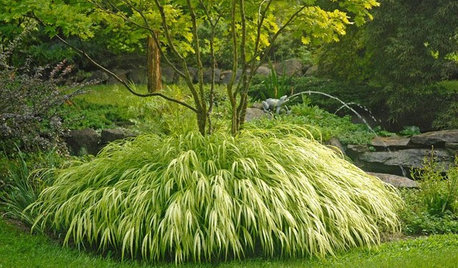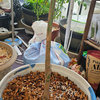Citrus hedge - what to take into consideration?
Hello,
Hoping to put citrus trees (Smith Red Valencia, Valentine Pummelo, Lee x Nova, Cara Cara, and perhaps a Powell?) along an east-facing wall, in a section that is around 25 feet long. Plan to keep them smaller, all branches within arm's reach.
Won't be going in right away. My soil is dense and need to put a French drain underneath, along with bringing the trees up off the ground in raised beds. So that still needs to occur
However, as I plan for the trees that will be going in the space, what are the suggestions for spacing? How close can they be and still be successful?
Thanks,
Ben
Comments (35)
hoosierquilt USDA 10A Sunset 23 Vista CA
10 years agoWell, if you Google "citrus hedge" or "citrus screen", you'll come up with a few nice photos. There is even a "citrus hedge" thread in our forum:
http://forums.gardenweb.com/forums/load/citrus/msg0619142917751.html
I would say plant about 4-6 feet apart, since you're going to want the canopies to meet. I would suggest using the same semi-dwarfing rootstock (Carrizo/Troyer or C35 for cultivars compatible with those rootstocks) for each cultivar, to keep the height down and to help them grow at a similar rate. As the trees grow taller, to keep each cultivar at relatively the same height, you may have to drop crotch prune those that are more vigorous. I agree - I have a "no ladders" rule in my garden. All my fruit must be pickable from the ground. Citrus trees make excellent hedges. Here are a few links:
http://nestandbloom.com/2011/05/good-hedges-make-good-neighbors-citrus-edition/
http://www.crfgsandiego.org/Presentations/CITRUS%20PRUNING.pdf (this is a fantastic tutorial on pruning citrus in general by one of our CRFG members who is really a pruning expert)
http://homeguides.sfgate.com/tree-fruit-hedge-planting-distance-50515.html
Patty S.
Related Professionals
Franconia Landscape Architects & Landscape Designers · Mountain Brook Landscape Architects & Landscape Designers · San Juan Landscape Architects & Landscape Designers · Englewood Landscape Contractors · Fuquay-Varina Landscape Contractors · Hannibal Landscape Contractors · Inglewood Landscape Contractors · Los Banos Landscape Contractors · North Ridgeville Landscape Contractors · Point Pleasant Landscape Contractors · Rosemount Landscape Contractors · Secaucus Landscape Contractors · Shaker Heights Landscape Contractors · Yuba City Landscape Contractors · Oxon Hill Landscape ContractorsUser
Original Author10 years agoMUCH APPRECIATED Patty and Johnmerr.
Durling's semi-dwarf rootstock is Trifoliate (said their rootstock for standard trees is C35). Not knowing much about it, will that be ok?
hoosierquilt USDA 10A Sunset 23 Vista CA
10 years agoI LOVE C35. The only drawback with C35 is that it is not as tolerant with salty soils. So, if you're living within 1/2 mile of the ocean, probably not the best choice. I am 6 miles from the coast, and have zero issues with it. It is FAR more tolerant of Phytophthora than Carrizo/Troyer, and it is my trifoliate rootstock of choice for my area :-) It also produces a more vigorous, shorter tree, more precocious and bears earlier than Carrizo.
Patty S.
User
Original Author10 years agoI'm confused (Sorry, my newness to this all makes me much slower than i already am!)
Assuming I understood correctly, C35 is Durling's standard-sized tree rootstock; their semi dwarf-sized rootstock is trifoliate. Since I'm going with semi dwarf, the rootstock will be trifoliate, correct? Should I have gone with a standard-sized tree in order to obtain the C35 rootstock?
johnmerr
10 years agoBen,
I might be confused as well. For me I have "hedges".... rows and rows of Meyer Lemons; but they are the same variety and on the same rootstock. Different varieties of citrus produce different size trees, even on the same rootstock; so if you are making a hedge of different varieties, you might, for example put the Meyer on a standard (full size) root, because it is more of a bush; and maybe put the rest on semi-dwarf root. You might learn a lot from the journey, or ask a competent local citrus nurseryman to give you advice.
uncle molewacker z9b Danville CA (E.SF Bay)
10 years agoNow I am confused! Carrizo from Willits & Newcomb is "standard. While their C-35 is Semi-Dwarf.
Carrizo is a bit testy to get it established, but once it gets going it rocks. Having said that, i like C-35 much better overall as its forgiving and tolerant of my 8.6+ pH water supply!.
hoosierquilt USDA 10A Sunset 23 Vista CA
10 years agoC35 is a semi-dwarfing rootstock. I have NO idea why Durling's calls it a "standard". It is not. I've had this discussion with them in the past about it. I love them, they are a wonderful citrus grower, but C35 is more dwarfing the Carrizo. It will produce a tree about 25% smaller than Carrizo, and Carrizo is considered a semi-dwarfing rootstock. C32, C35, Carrizo, Troyer and Swingle are all trifoliates (being a trifoliate does not equate to "semi-dwarf", as Swingle is a trifoliate, but will produce a standard sized tree). In fact, the citrus orchards over at the Riverside Citrus Heritage Park are all on C35 now, as the trees are smaller, more manageable, and have a higher yield. As John and I have mentioned, the rootstock does play a large role in the size and precocity, as well as the yield of the cultivar, the cultivar itself will also present certain growth traits. So, you'll have to do some pruning to keep them even. So, here it is for everyone with regard to the more common rootstocks we see here in California (there are more than what I'm listing, but these are by far the most common you're going to see):
Standard rootstocks: Sour Orange, Macrophylla, Rough Lemon, Volkameriana, Rubidoux, Rich 16-6, and Swingle, with Swingle being what we see most frequently, and then Rubidoux and Rich 16-6. Macrophylla is used for lemons and Volkameriana is sometimes used for Cocktail pummelo (lemons are not compatible with trifoliate rootstocks and Cocktail is not a very vigorous cultivar, so it benefits from Volkameriana which is more vigorous, but does not provide as sweet of a fruit). Sour Orange is no longer used due to its lack of resistance to Tristeza. Rough lemon is primarily used for lemon cultivars.
Semi-dwarfing rootstocks (in order of size): Troyer/Carrizo. Very common here,trifoliates, both are essentially indistinguishable from each other and are frequently considered interchangeable. C35 & C32 (again, siblings of each other). C35 & C32 are also trifolates, gaining in popularity commercially over T/C due to is precocity and increased yield. Also, higher resistance to phytothphora than T/C, but more sensitive to salt in the soil. C/T more susceptible to zinc and manganese deficiencies.
Dwarfing Rootstocks: Flying Dragon (the most dwarfing rootstock used for citrus), Cuban Shaddock (also the same as Yuma Ponderosa Pummelo). Both are quite dwarfing, Cuban Shaddock is used frequently by Four Winds Growers.
Here are some links for folks to read about rootstocks:
http://chislettnavel.com.au/wp-content/uploads/2013/03/C-35+citrange+sml.pdf
http://users.kymp.net/citruspages/trifoliates.html#other
http://www.citrusvariety.ucr.edu/links/documents/Bitters.pdf
Patty S.
This post was edited by hoosierquilt on Thu, Aug 22, 13 at 23:35
johnmerr
10 years agoPatty,
As always you are a fountain of information.I have used Carrizo and I "believe" it to be a full standard rootstock; I have been told so by several purveyors of citrus; and in my experience it produces a full sized tree.
I could well be wrong about this, but I only have my experience to back it up.
For my Meyers here in the tropics I only use Macrophylla; it used to be a widely used rootstock for lots of citrus because of its resistance to lots of things and its vigorous growth habits. Now it is mostly used for lemons; and especially for lemons in hot climates.
User
Original Author10 years agoYou continue to AMAZE, you rock star, you!!! Thank you :) Seems like just about every one of your posts could be a page out of a "Foolproof Way to Grow Citrus Successfully" book! For dummies like me!
So when Durling told me "trifoliate" I needed to have asked them for more specifics then. Do you know which trifoliate they use, by chance, for their semi-dwarf trees?
hoosierquilt USDA 10A Sunset 23 Vista CA
10 years agoUsually Durling uses C35, as it is becoming so popular with commercial citrus growers in California. But, you can ask them WHICH trifoliate they are referring to.
John, Carrizo/Troyer supposedly will produce "medium" sized trees (although slightly larger than on Sour Orange), and if you ask the main growers here in California, they will categorize both Carrizo and Troyer as semi-dwarfing rootstocks. I think though, over a 10 to 15 year period of time, a tree on Carrizo/Troyer will attain the same height as the "standard" rootstocks. At least, that has been my observation. Carizzo is by far the most popular rootstock used in California for compatible cultivars. C35 definitely will produce a more compact tree, I've had several conversations with the curators of the California Citrus Heritage orchards as well as the folks at the UC Riverside Citrus Variety Collection about C35, in my attempts to find a better rootstock for my issues with phytophthora, and also in reading about C35. Our lemons here are mainly put on Rough Lemon. You'll see some on Volkameriana (as well as Cocktail on Volk), and rarely Macrophylla.
Here is an article about size characteristics of some of the rootstocks we've been discussing:
And interestingly, this article shows C/T ending up being the same or larger than Swingle, over a long period of time:
http://www.crec.ifas.ufl.edu/academics/faculty/castle/PDF/HortScience_Hamlin_45_6.pdf
So, I find it very interesting that growers here all seem to have a different perception of what is really "semi-dwarfing" and what is "standard" for citrus rootstocks here. Clausen's considers C/T semi-dwarfing and sells them as semi-dwarfing, and Swingle and Volk as standards. And, if you walk into Walter Anderesen Nursery or some of the other large nurseries/garden centers here, they will tell you the same thing.
Patty S.
uncle molewacker z9b Danville CA (E.SF Bay)
10 years agoThank you Patty for all the info ! [I sure hope that you are cutting / pasting from somewhere rather than delivering from the top of the noggin']. The queen of citrus has delivered more archive-able posts!
This is a highly relevant discussion as spacing has been very much on my mind with the mix of varieties and rootstocks i've put in the ground in Danville. I may play musical chairs with the plantings based on the info.
BTW: I am actually pleased to hear that the Carizzo will get large someday - but not too quickly. [I do see more vigorous growth from the C35].And John, Macrophylla carries my Meyer and Bearss limes in Napa and is really liking the sandy/loamy soil. I avoided Macrophylla in Danville due to clay soil and publications referencing its poor performance on clay.
thank you all ! - George K
User
Original Author10 years agoAfter a few e-mails back and forth, I confirmed this about Durling's trees:
- Semi-dwarf (low branching, bush-like) rootstock used is "Rubidoux."
- Standard citrus is C35 except Lemons and Limes, they are on Macrophylla-Sour. All the C35 trees are "tree shaped" without any low branchingSo, I'm assuming Durling's standard would not suitable for my needs of growing a lower-to-ground-sized tree?
hoosierquilt USDA 10A Sunset 23 Vista CA
10 years agoWell, C35 will stay compact. They're calling it their "standard" rootstock, but it's not standard sized :-) Rubidoux is a bit smaller, but I think C35 will produce more fruit for you. Now, "low branches" is relative :-) I bet when you plant their 5 gal trees on C35 that you'll find the branches will be about 2' off the ground, Unless you're buying 15 gal trees, the 5 gals will will have pretty low branches. And, most citrus are not "bush-like" even if on Rubidoux with rare exception (Meyer Lemons, most Satsumas). The will eventually be tree-like and not bush-like, even if on Rubidoux. Just sayin' :-) It's more a cultivar expression than the rootstock expression.
Patty S.
User
Original Author10 years agoSo very interesting Patty. Wonder what their reasoning is? I did speak with them later in the afternoon to find out just how high their trunks get before they allow their standard trees to start branching and they did say 20-22" on all sizes, 5-15 gal, but who knows?
Well, not knowing all these intricacies, I ordered 15 gal semi-dwarf trees of Kishu, Gold Nugget, and Tango on Weds (not for hedge) and plan to pick them up tomorrow. Hopefully they'll work out ok? (They have a 20% restocking fee.) WWPD? (What Would Patty Do?)
When you've purchased from Durling, can I assume you've purchased their "standard" trees?
hoosierquilt USDA 10A Sunset 23 Vista CA
10 years agoOkay, so my guess was correct (and that was based on my 5 gal trees from Durling on C35, so it was a pretty easy guess). What is Durling reasoning for using C35 as their "standard" rootstock? Easy - their reasoning for using C35 as their "standard" is it is becoming the "standard" go-to rootstock for commercial growers here in S. California. Not because it produces a "standard" sized citrus tree, but because it does NOT. It produces a tree that stays smaller, doesn't need to be hedgerowed so heavily (ask John about this commercial technique), and is a more heavy producer of fruit as well as produces earlier than other rootstocks. So, they're going to stock what the industry is demanding (remember, they're a commercial wholesaler, and we home growers/hobbyists are lucky to be able to purchase from them).
Patty would buy those trees :-) They are my 3 very favorite mandarins, along with Page (which is my Minneola replacement). Yum. And yes, C35 is my rootstock of choice due to the high propensity for Patty to over-love her young citrus and provide too much water to them, thus creating an optimal environment for Phytophthora. I really need to completely re-do my watering system, rip it all out, re-dig wells for all trees, and install two micro-sprinklers on each tree. Once I have a spare $5,000 to do that, it will get done. I can then better regulate water to my citrus of varying ages and sizes.
Patty S.
User
Original Author10 years agoBut would you buy those 15-gal trees on Rubidoux? :) That's what I ordered (before you educated me), and will be leaving to go pick up shortly (they close at 11a), unless you think I should hold, pay the 20% restocking fee, and re-order them as standard C35's.
gregbradley
10 years agoMy Durling Semi-Dwarf Tango bought as a 15gal this spring is already at 7'. I would buy the Semi-Dwarf unless you have lots of room.
I don't think it makes a big difference and I know you need to leave soon, like in the next half hour.
User
Original Author10 years agoAppreciate the info about your Tango as well as your input Greg. I ultimately decided to wait; it came down to a number of factors, which included the possibility of the C35, but also it freed up our time a little more today and may give me an opportunity to buy a few more trees from them. Hopefully I made the right decision! Thanks again.
hoosierquilt USDA 10A Sunset 23 Vista CA
10 years agoSure, Ben! As long as they're all on the same rootstock, they will tend to grow at similar rates (excluding any particular cultivar's predisposition to grow one way or another). Rubidoux MIGHT be a wee bit smaller, but truly not by much. In fact, I would be if one was on C35, you'd hardly notice the difference, both produce a more compact tree. Just that C35 may produce a bit more fruit than Rubidoux. If they have a Page mandarin, you'll want to snag that, as well as a Cocktail and a Valentine :-)
Patty S.
User
Original Author10 years agoThanks Patty. So is your answer, "sure ben, go with the rubidoux," or "sure ben, hold off and reorder with C35"? :)
At this point, the only concern I'd have about their 15 gal C35 trees is that I'm planning to limit their height to 6-7' and they'd already be starting nearly 2' off the ground.
I know you're approaching the size of your citrus trees similar to the way I hope to. When you've bought from Durling, I'm assuming you've gone with their standard C35's and not their semi-dwarf Rubidoux? Which of your trees did you purchase from Durling? http://s940.photobucket.com/user/hoosierquilt/story/1799
hoosierquilt USDA 10A Sunset 23 Vista CA
10 years agoNo, definitely go with the Rubidoux, it's a fine rootstock, and will keep your trees a bit smaller (not by much, but some) than C35. I have a couple of trees on Rubidoux and I've grafted to Rubidoux. It actually does very well in the inland empire area (bet you guessed that!) Ben, all my trees will be not taller than 6 to 7'. I am only 5'4". I will NOT use a ladder to pick fruit (I'm an RN, and I can tell you that over 85% of injuries incurred at home involve a ladder, no kidding!!) I might sound a little paranoid, but I've spent enough time working in the ER to say, "Are you kidding me, another ladder related injury?!?"
Yes, the trees I bought from Durling were on C35, but at the time, I was having SO much issue with Phytophthora, and the only trees unaffected were on C35, so for me and my special issues, it was the reason I selected C35. Don't worry at all about Rubidoux - jeepers, 3/4 of the older commercial orchards in Riverside are on Rubidoux :-) You can drop crotch prune anything on anything to keep it at the height you want, so don't worry about the height. I'd just try to pick all the same rootstock as that will help to keep the trees at about the same height. All you'll have to deal with then, is each cultivar's own growth habits, and then each individual tree's own vigor :-) And, that's normal stuff with citrus.
Patty S.
Here is a link that might be useful: Ladder Injury Statistics
This post was edited by hoosierquilt on Sun, Aug 25, 13 at 0:05
yukkuri_kame
10 years agoAssuming one is going for a 'cocktail' hedge, with many varieties of citrus, will variability of foliage density be a concern?
Of course, different varieties will look a bit different in leaf shape, color and growth habit. But if the purpose is privacy, are there some cultivars that will just not create a dense screen?
My very limited observation of isolated trees is that lemons and limes produce less dense foliage than grapefruits or oranges. Please tell me I am wrong.
hoosierquilt USDA 10A Sunset 23 Vista CA
10 years agoSurprisingly, foliage density is pretty consistent with citrus cultivars across the board. Some might be more weepy, some more upright in their growth characteristics, but as far as foliage density, they're all pretty much the same. And with pruning that can be evened out, if necessary. My Eureka lemon is very dense (which can make for some tricky fruit picking. I use my rose gloves.)
Patty S.
User
Original Author10 years agoAw, thanks Patty. Sorry, I had been taking so much time to treat my symptoms of this "citrus fever" (researching, etc.), that I was neglecting other responsibilities!
Oh my, those ladder statistics are sobering. Had a husband of a friend who took awhile to recover from a serious ladder fall (he was wearing flip-flops!). Think of him every time I'm on a ladder and exercise extra caution.
Well, thanks to you and Greg, I'm going to pick up 15 gal, semi dwarfs of Tango, Gold Nugget and Seedless Kishu. Just spoke with Durling; no 20% restocking fee... woo-hoo!
Thought of picking up 5 gals of Smith Red Valencia, Valentine Pummelo, and a Cara Cara for my hedge, but since they only have stock of Valentine Pummelo, I'm considering waiting a couple months until they get stock (unless you think I should buy what they have now? Can't beat $14.75! But it's also nice if they can "babysit" them for me until I'm ready.)
hoosierquilt USDA 10A Sunset 23 Vista CA
10 years agoAh, I would buy that Valentine. The CRFG's routinely clean Durling's out of this cultivar as they are the only growers in the state of California propagating the Valentine. Unless they're willing to let you pay for one now, and wait until the rest of the varieties you're wanting are in stock so you can then take delivery of all of them. Great choices, all very excellent tasting. I would suggest adding a Page mandarin, and then you've got all your need. Oh, and a Santa Teresa Femminello lemon (the "limoncello" lemon from Italy). That's grown by Willits & Newcomb up in Bakersfield, and they supply Costcos up in the IE, so you might be able to have one sent there for you (kind of a long drive for 1 citrus tree, lol!)
Sounds like you're going to need two hedges!
Patty S.
User
Original Author10 years agoOops, realized I left a few key words out of my sentence: "but since they only have stock of Valentine Pummelo, I'm considering waiting a couple months until they get stock." I left out the part that says they only have stock of 24" WOODEN BOXES! Lol. They have stock of the other cultivars. So, that's why I'm needing to wait. I will ask, however, if I can pre-pay for the Valentine Pummelo. Great idea.
Will also look a little further into the other two cultivars you suggest. Preference between Lee x Nova and a Page?
Yes, sounds as though I might need two hedges! And I would consider it, but there's another 25' section of that wall that I hope to put avocados... I'll be posting there soon Patty :)
hoosierquilt USDA 10A Sunset 23 Vista CA
10 years agoAh, that's hard. I have them both, and they are both exceptional. They are different. Lee x Nova reminds me a bit of Seedless Kishu. But, the Page mandarin hybrid (crossed with the Minneola) makes THE best citrus juice ever ever. Love it, oh my gosh. And it is a crazy heavy bearer, almost as heavy as the Meyer lemon. I have to thin it so the fruit doesn't end up like a gazillion golf balls :-) It would be hard to pick between the two, but Page I use almost exclusively for juice (I wake up and can't stop thinking about making juice during the season), and Lee x Nova is just excellent for eating out of hand. Very rich and complex, very sweet. Not blah or "one note", or sour at all. Plus, both hang on the tree very well.
Patty S.
User
Original Author10 years agoCan Page be eaten out of hand as well?
And do any of these "alternate-bear"?
hoosierquilt USDA 10A Sunset 23 Vista CA
10 years agoYes, it sure can. Page will alternate bear a little bit (although this year looks to be about as heavy as last year). All mandarins tend to alternate bear, and if you leave the fruit on too long, you can force into an alternate bearing state for a year or two. Normal state of affairs for most mandarins. Some are worse than others (like Honey, which strongly alternate bears). I have so many mandarins, I don't really worry about it, though :-)
Patty S.
Kippy
10 years agoPatty, how do you juice your pages? Special juicer? or would the kitchenaid juicer attachment I have work? (I need to clean off the top of an old and very large mandarine tree-will not look at ladder stats right now-hurt my bad foot just yesterday from a wrong step off the ladder)
hoosierquilt USDA 10A Sunset 23 Vista CA
10 years agoI just use my little Black & Decker juicer. Nothing fancy, but I would think your Kitchenaid attachment would work as well. I have that attachment for my Kitchenaid mixer, but frankly, too much of a hassle to use. Ugh, ladders!
Patty S.
User
Original Author10 years agoOut of curiosity, which mandarins would you say alternate-bear the least in the spectrum of mandarins? Sounds like Honey is on one extreme. Where would Kishu, Tango and Gold Nugget fall?
Are there other citrus cultivars that exhibit this same behavior?
hoosierquilt USDA 10A Sunset 23 Vista CA
10 years agoYes, Honey is extreme, and known to be extreme. My Seedless Kishu has its first fruits this year, but every year at the UC Riverside Citrus Collection, their Kishus have been loaded. Same with Tango. Gold Nugget is probably the most likely of the three you mention to show some alternate bearing, mainly because, I think, the fruit will hang exceptionally well on the tree, so you might leave the fruit on and use it as needed. That can cause a tree to alternate bear. Pruning every season just a bit can help stimulate more fruit bearing branches, so that can stop the alternate bearing if you start to see that happening. Or, removing the fruit within a reasonable amount of time. Also, cultivars that tend to bear very heavily can alternate bear if not thinned. Page mandarin can do that, and even the illustrious Meyer lemon if you don't pick the fruit regularly (I forced mine into an alternate bearing state the first year I moved into my house due to the enormity of the amount of fruit on that tree). The satsumas tend to be more alternate bearing as well (sort of famous for it), also, but since you don't have any, no worries there. And, Valencia oranges also will alternate bear, again, because the fruit can hang on the tree for so long.
Patty S.


















johnmerr